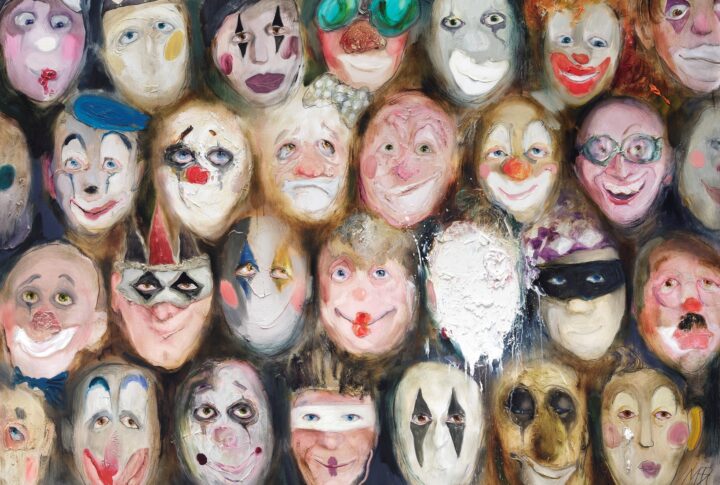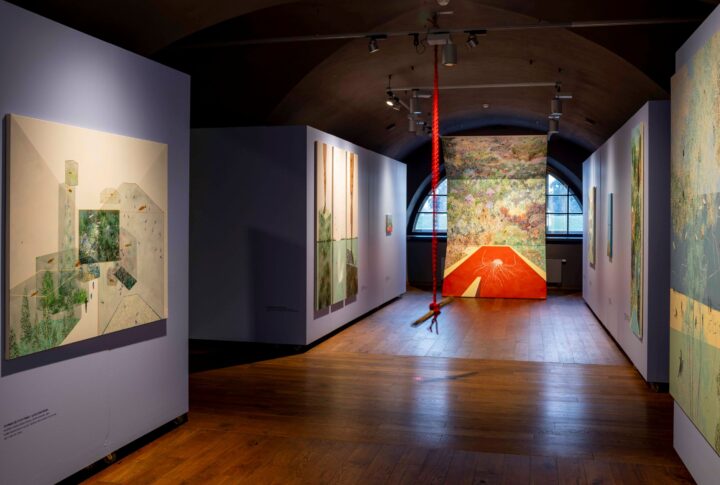The Voice of Reason. Inga Bunkše on the annual group exhibition of Latgale’s artists

Questions like “Who did you vote for?” and “How did you cast your vote?” often come up in discussions at polling stations. Let us imagine a scenario where a vote must be cast in a literal sense. Where the act of voting surrenders the citizen’s actual voice to a political figure who then speaks on behalf of the electorate – be it one, three, or five thousand voters – for the entire electoral cycle. Whom would you entrust with your voice? Presumably, someone wise, reliable, and just. But there is a critical caveat: the voices must coalesce into a consensus.
This way, if every voter clamours for “grand residences”, the politician gets a lavish home (see Aivars Bulis, “I Vote For…”). If the collective desire gravitates towards “the latest iPhone”, that is what the elected official gets. In essence, the electorate’s aspirations dictate the politician’s rewards. But what if the collective voice were to prioritise the common good? Instead of doing everything to line one’s pockets, imagine channelling this power towards the progress of the city or the nation, ensuring just and equitable governance, combating climate change, promoting peace, and unequivocally rejecting territorial conquest. What if the citizens’ voices collectively compelled politicians to act with integrity, refrain from deceit, evasion, and opportunism, and honour their commitments? Would one then not contend that every single vote is instrumental in shaping our collective future? Ideally, yes, but some might argue otherwise: “That cannot be the case; my single vote will surely make no difference.”
A universal sense of disbelief and disillusionment seems to have taken hold in Latvia – many feel disempowered, believing that their actions will never bring desired change. Yes, people vote, elect and re-elect their representatives and still observe a firmly rooted status quo. Could this stagnation stem from our persistent failure to reflect on the integrity and character of those we elect? Indeed, social activism seems to have fallen out of favour.
Ahead of the municipal elections in the country, the Rothko Museum invited artists from the Latgale region to contribute to an exhibition with a thought-provoking theme, its Latvian title playing on the homonymy of ‘desire’ and ‘election’.
The exhibition statement reads: “…when all is said and done, every election involves an active interplay between our personal ambitions and collective choices, where individual desires and value-driven motivations inevitably clash or merge with our collective action and our shared accountability.” Yet, many artists have chosen to remain within their comfort zones, engaging with the theme only in the titles of their contributions.
That said, Aivars Bulis offers a cuttingly ironic take on elections, envisioning a fictional political party, “Dreamers”, whose ballot paper exposes the inherent self-interest of human nature. The piece stands out with its sharp wit and unconventional animation technique. In a similar vein, Jurika Bakāne offers a satirical caricature on the “black PR” of election campaigns, capturing how power-hungry candidates resort to unscrupulous tactics to undermine their opponents.
Several works in the exhibition evoke our antebellum aspirations – our peaceful longings and desires, our hopes to see our children thrive. But can our children be truly happy while a war is raging right next door or while our planet is slowly dying due to man-made climate change?
However, if one suspends the expectation that artists must engage in civic activism, the exhibition can instead be viewed as an artistic meditation on the fundamental themes of our existence. Seen through this lens, depictions of our daily life (Annele Slišāne, Nataļja Krjukova) become philosophical reflections on our experience of time, space, and materiality. A deeply human longing for universal and lasting peace is palpable in nearly every depiction of the natural world (Ruta Štelmahere, Ilze Griezāne, Ludvigs Bērziņš, Agra Ritiņa). Even the abstract works, though not overtly challenging the aesthetic discourse, seem to invite a search for hidden beauty.
Gita Palma’s “Grave Keeper” introduces a striking dissonance. The first contradiction lies in the painting’s spontaneity, as if the image were a snapshot of a fleeting moment – in stark contrast to the solemn gravitas and permanence associated with a cemetery, where eternity prevails. The composition further challenges viewers to interrogate their perception of reality and the enduring nature of beauty. Similar tensions and imbalances between the subjective and public realms, the intimate and the universal emerge in Aiva Žūriņa’s “Heritage” and Anatolijs Zelčs’ “The Age of Silo People”.
Ultimately, the exhibition offers a stimulating visual experience that wows with its stylistic, formal, and material diversity. Realism, hyperrealism (Svetlana Saveļjeva), surrealism (Marina Krasovska, Laura Lāce), and abstraction, amidst a wealth of colour, texture, form, and line, engage both the eye and the mind. The featured artists have successfully transformed their material – textile and metal, porcelain and clay, cast iron, glass, acrylic resin, and many more – into original aesthetic experiences through felting, weaving, moulding, vitreography, and other techniques. The abundance of artistic thought and expression is firmly rooted in the dedicated efforts of Latgale’s art educators and educational institutions.
The exhibition’s thoughtful layout and design, a hallmark feature through the years, guide the viewer to unexpected intersections among the artworks on display and new interpretations of familiar motifs.
To wrap things up, a final thought on the subject of elections: we live in a time when the line between fact and fiction, reality and absurdity, grows increasingly blurred – not least in political discourse. In this sea of uncertainty, art remains a formidable instrument for interrogating narratives that shape our personal lives and the political landscape. So, let us harness its potential!
In the coming election, let us heed the voice of reason.
Inga Bunkše, Mag. art.
The exhibition is on show from 7 March to 18 May.
Read more: https://rothkomuseum.com/en/ekspozicija/desire/
Publicity image: Jurika Bakāne “Who Wants Dinner?!”. Oil on canvas, 80 x 120 cm, 2024. Photo by Didzis Grodzs







